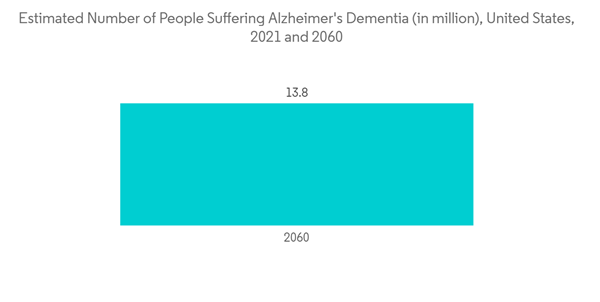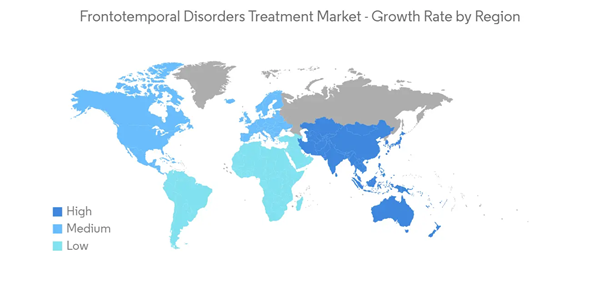The frontotemporal disorders treatment market is expected to register a CAGR of 7.2% during the forecast period.
This product will be delivered within 2 business days.
Key Highlights
- The outbreak of the pandemic positively impacted the market. The cases of dementia, anxiety and cognitive impairment significantly increased during COVID-19 among all age groups. For instance, according to a study published by the National Center for Biotechnology Information (NCBI) in June 2020, people with cognitive impairment and dementia, in general, were more likely to have a greater risk for COVID-19 exposure and both caregivers and care receivers were undergoing considerable stress than usual during the pandemic. Such a scenario increased the rate of frontotemporal disorders among people.
- Furthermore, people who have suffered from COVID-19 have also reported suffering from frontotemporal disorders. For instance, a study published in the journal Frontiers in Aging Neuroscience in October 2020 found that some patients who recovered from COVID-19 had sleeplessness, depression, anxiety, post-traumatic stress disorder, and cognitive impairment. Thus, considering such factors, the market witnessed considerable growth during the pandemic and is expected to continue the same during the forecast period.
- The growing prevalence of dementia and other frontotemporal disorders is one of the major factors propelling the market growth. For instance, as per the data published by the NCBI in March 2021, an estimated 6.2 million Americans aged 65 and older were known to be living with Alzheimer's dementia in 2020. The report also stated that the number could grow to 13.8 million by 2060, barring the development of medical breakthroughs to prevent, slow, or cure Alzheimer's dementia.
- Similarly, the World Health Organization (WHO) reported in September 2022 that more than 55.0 million people worldwide were currently known to have dementia. The report also stated that nearly 10.0 million new cases are reported every year.
- Furthermore, the same source also stated that dementia is currently the seventh leading cause of death among all diseases and one of the major causes of disability and dependency among older people globally. Also, dementia is one of the major causes leading to frontotemporal disorders. Therefore, increasing cases of dementia are expected to surge the rate of frontotemporal disorders, thereby propelling market growth.
- The increasing drug development grants and funding by the government, as well as non-government, are also boosting market growth. There are currently no FDA-approved disease-modifying treatments for frontotemporal disorders, and symptomatic treatment provides only limited benefit to patients.
- Recent scientific findings have improved our knowledge of the underlying pathogenic mechanisms of a frontotemporal disorder, fostering the development of potential disease-modifying therapies. Therefore, to accelerate the research and drug development procedure, in December 2020, the Association for Frontotemporal Degeneration (AFTD) and the Alzheimer's Drug Discovery Foundation (ADDF) issued a joint request for proposals (RFP) for new research aimed at advancing and accelerating the diagnosis and treatment of frontotemporal disorders, the most common dementia in people under 60. The funding for this RFP is being provided through the Treat FTD Fund, with award recipients receiving up to USD 2.0 million. Thus, such a scenario is anticipated to accelerate the demand for frontotemporal disorders treatment over the forecast period.
- However, cost issues and a lack of awareness across several regions will likely hinder market growth over the forecast period.
Frontotemporal Disorders Treatment Market Trends
Antidepressants Segment is Expected to Witness Growth Over the Forecast Period
- The antidepressants help to give relief from the symptoms of depression. It is also used to treat anxiety, social and seasonal affective disorders. These drugs generally correct chemical imbalances of neurotransmitters in the brain and are responsible for changing behavior and mood swings. There are different types of antidepressants, such as citalopram (Celexa), escitalopram (Lexapro), fluvoxamine (Luvox), fluoxetine (Prozac, Sarafem), sertraline (Zoloft), and paroxetine (Paxil).
- Most antidepressants belong to these groups, selective serotonin reuptake inhibitors (SSRIs), serotonin and norepinephrine reuptake inhibitors (SNRIs), and atypical antidepressants. However, antidepressants have certain side effects, such as weight gain, sleepiness, diarrhea, nausea & vomiting, and sexual problems.
- The increasing cases of anxiety, dementia, depression, and Alzheimer's dementia is the major driver for the segment's growth. For instance, as per the report published by the Vietnam Country Policy in May 2021, the most common types of mental health problems among children of Vietnam are anxiety, loneliness, and depression. It also reported that most studies indicate children are more susceptible to depression than adults. Similarly, as per the report published by NCBI in April 2022, the majority of individuals with depression experience sleep disturbances. It also reported that depression is also overrepresented among populations with various sleep disorders.
- Although sleep disturbances are typical features of depression, these symptoms sometimes appear before an episode of depression. Therefore, this may increase the demand for antidepressant drugs as it is generally used to treat depression and related symptoms such as insomnia, dementia, and stress, thereby propelling the segment growth during the forecast period.
- The increasing research work and product launches by the key players are also anticipated to boost segment growth. For instance, in March 2022, Sun Pharma entered into an exclusive patent licensing agreement with Danish drugmaker Lundbeck to market and distribute its version of antidepressant medication Vortioxetine in India under the brand name Vortidiftm. Vortioxetine is a novel antidepressant with multimodal activity, which is approved to treat the major depressive disorder (MDD) in adults. The product is approved in over 80 countries, including the US, EU, Canada, and Australia. Therefore, such positive developments are expected to propel the segment's growth.
- Therefore, significant segment growth is expected during the forecast period owing to the above-mentioned factors.
North America is Expected to Witness Growth Over the Forecast Period
- North America is expected to dominate the overall frontotemporal disorders treatment market during the forecast period. The growth is due to increasing cases of dementia, anxiety, and frontotemporal disorders, the rising geriatric population, and increasing research work related to frontotemporal disorders treatment.
- For instance, according to the report published by the Alzheimer's and Dementia Organization Canada in January 2022, around 569,600 Canadians were living with dementia in 2020, and around 747,000 Canadians will be living with Alzheimer's or another dementia in 2022. The report also stated that around 124,000 Canadians were diagnosed with dementia in 2020, and around 955,900 Canadians are expected to live with dementia by 2030. Therefore, such instances are anticipated to propel market growth in the North American region.
- Key product launches, product approval, high concentration of market players or manufacturer's presence, acquisition and partnerships among major players, and increasing cases of dementia and frontotemporal disorders in the United States are some of the factors driving the growth of the frontotemporal disorders treatment market in the country.
- For instance, in December 2021, the US FDA approved Caplyta (lumateperone) for treating bipolar depression in adults. Caplyta, an atypical antipsychotic from the biopharmaceutical company Intra-Cellular Therapies, is the only drug approved by the FDA for the treatment of depressive episodes stemming from bipolar I or bipolar II disorder in adults as monotherapy or adjunctive therapy with either valproate or lithium.
- Therefore, owing to the aforesaid factors, the growth of the studied market is anticipated in the North America Region.
Frontotemporal Disorders Treatment Market Competitor Analysis
The frontotemporal disorders treatment market is fragmented in nature and consists of many major and small players. The competitive landscape includes an analysis of a few international as well as local companies which hold the market shares and are well known, including Apotex Inc., AstraZeneca plc., Auro Pharma, Johnson & Johnson, Mylan N.V., Pfizer Inc., Sanofi S.A., Teva Pharmaceuticals USA, Inc., among othersAdditional benefits of purchasing the report:
- The market estimate (ME) sheet in Excel format
- 3 months of analyst support
This product will be delivered within 2 business days.
Table of Contents
1 INTRODUCTION
4 MARKET DYNAMICS
5 MARKET SEGMENTATION (Market Size by Value - USD Million)
6 COMPETITIVE LANDSCAPE
Companies Mentioned (Partial List)
A selection of companies mentioned in this report includes, but is not limited to:
- Apotex Inc.
- AstraZeneca plc.
- Auro Pharma
- Viatris Inc. (Mylan N.V.)
- Pfizer Inc.
- Sanofi S.A.
- Teva Pharmaceuticals USA, Inc.
Methodology

LOADING...










